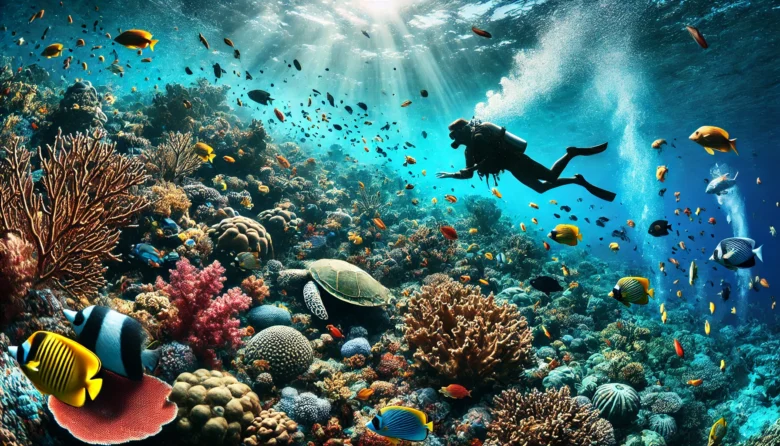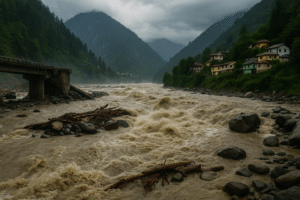When you think of coral reefs, images of vibrant colors, exotic fish, and crystal-clear waters might come to mind. But coral reefs are much more than a beautiful underwater landscape; they are among the most diverse ecosystems on Earth, playing a crucial role in marine biodiversity. Yet, they are facing unprecedented threats due to climate change, pollution, and human activity. In this blog, we’ll take a closer look at the science behind coral reefs, examining their biodiversity and the pressing need for conservation to safeguard these incredible ecosystems.
What Are Coral Reefs?
Coral reefs are often referred to as the “rainforests of the sea” because of the incredible diversity of life they support. These underwater structures are formed by colonies of tiny animals known as coral polyps. The polyps secrete calcium carbonate, which creates the hard, rock-like structures we know as coral reefs. What’s remarkable about coral reefs is that they support a vast array of marine life, including vibrant fish, sea turtles, sponges, crustaceans, and even sharks.
Corals have a unique relationship with a type of algae called zooxanthellae, which lives within their tissues. The algae provide the coral with food through photosynthesis, while the coral offers the algae a safe home. This symbiotic relationship is what gives coral reefs their brilliant colors. However, when corals are stressed—due to rising ocean temperatures or pollution—they expel the algae, leading to a phenomenon known as coral bleaching.
The Importance of Coral Reefs to Marine Biodiversity
Coral reefs cover less than 1% of the ocean floor, yet they support over 25% of all marine species. This makes them one of the most productive and diverse ecosystems on Earth. The intricate structures of coral reefs offer habitat, food sources, and breeding areas for a wide variety of species. Let’s take a closer look at why coral reefs are vital for biodiversity.
A Home for Marine Life
The intricate structures of coral reefs create ideal habitats for fish and other marine animals. Small fish find shelter in the crevices of the reef, while larger predators like sharks and rays patrol the waters around it. Many species would find it difficult to survive without coral reefs, as they rely on them for shelter and nourishment.
For example, the Great Barrier Reef in Australia, the largest coral reef system in the world, is home to over 1,500 species of fish, 411 types of hard coral, and a wide range of mollusks, sponges, and starfish. This biodiversity makes coral reefs not just an essential part of marine life but also a key indicator of the ocean’s health.

Food Security for Humans
Coral reefs are also critical for human survival. Approximately one billion people worldwide rely on fish from coral reefs as their primary source of protein. Reefs support local fisheries, which are especially important for small island nations and coastal communities. The biodiversity of coral reefs ensures a steady supply of fish and other marine resources.
Take the Philippines as an example. The country’s coral reefs contribute significantly to the livelihoods of millions of people who depend on them for food, income from fishing, and eco-tourism. However, overfishing and destructive fishing practices like blast fishing are depleting these valuable resources, threatening both marine life and human food security.
Natural Coastal Defenses
Coral reefs act as natural barriers, protecting coastlines from the damaging effects of waves, storms, and erosion. The structure of the reef absorbs the energy from incoming waves, reducing their impact on shorelines. In many tropical regions, coral reefs play a crucial role in protecting human settlements from storm surges and tsunamis.
For instance, in the 2004 Indian Ocean tsunami, healthy coral reefs in some locations helped reduce the impact of the massive waves by acting as natural barriers. Coastal communities with intact coral reefs experienced less damage compared to areas where the reefs had been degraded or destroyed.
Threats to Coral Reefs
Unfortunately, coral reefs are facing significant threats that could lead to their decline or even extinction in some areas. Let’s explore the main challenges that coral reefs are up against.
Climate Change and Coral Bleaching
Climate change is one of the most significant dangers facing coral reefs. As global temperatures rise, so do ocean temperatures. Corals are incredibly sensitive to changes in temperature; even an increase of just 1–2°C can cause stress. When stressed, corals expel the algae living in their tissues, causing them to lose their color and turn white—a process known as coral bleaching. While bleached corals are not dead, they are more vulnerable to disease, and if the stress persists, they can die.
A major coral bleaching event occurred in 2016 on the Great Barrier Reef, where nearly 30% of the coral was lost due to sustained high sea temperatures. These bleaching events are becoming more frequent and severe, putting entire ecosystems at risk.
Pollution
Pollution is another significant threat to coral reefs. Runoff from agriculture, sewage, and oil spills can introduce harmful chemicals and sediments into the ocean, which can smother coral reefs and deprive them of the sunlight they need for photosynthesis. Plastic waste is also a growing problem, with coral reefs often becoming entangled in or smothered by marine debris.
In 2019, a study conducted by the Ocean Conservancy found that plastic pollution can increase the likelihood of disease outbreaks in coral reefs. Coral that comes into contact with plastic waste is 20 times more likely to suffer from diseases like black band disease, which can kill entire sections of reef.
Overfishing and Destructive Fishing Practices
Overfishing and practices like blast fishing and cyanide fishing can cause irreversible damage to coral reefs. Overfishing depletes the populations of key species that help maintain the balance of the reef ecosystem. Destructive fishing practices, such as the use of explosives to stun fish, can destroy the physical structure of the reef itself, leaving it unable to recover.
In Southeast Asia, blast fishing has caused widespread damage to coral reefs, reducing their ability to support marine life and protect coastal communities from storms.
Conservation Efforts: Protecting Coral Reefs
Despite these challenges, there are ongoing conservation efforts around the world aimed at protecting and restoring coral reefs. Here are a few notable strategies and initiatives:
Marine Protected Areas (MPAs)
One of the most effective ways to conserve coral reefs is through the establishment of Marine Protected Areas (MPAs). MPAs restrict human activities like fishing and tourism in designated areas, allowing coral reefs and marine species to recover and thrive. In places like the Maldives and Australia, MPAs have been successful in preserving coral reef ecosystems and boosting biodiversity.
Coral Restoration Projects
Coral restoration projects are another critical effort in the fight to save coral reefs. These initiatives often involve growing coral in nurseries and then transplanting them onto damaged reefs. Coral nurseries help to repopulate reefs and improve their resilience to environmental stressors.
For example, the Coral Restoration Foundation in Florida has successfully planted tens of thousands of corals back onto the Florida Reef Tract, helping to restore a vital ecosystem that has been severely damaged by bleaching and storms.
Reducing Carbon Emissions
Because climate change is the leading cause of coral bleaching, reducing global carbon emissions is essential to saving coral reefs. Governments, businesses, and individuals all play a role in transitioning to renewable energy sources and adopting more sustainable practices that can help mitigate the effects of climate change.
Conclusion: The Urgency of Coral Reef Conservation
Coral reefs are not just beautiful underwater landscapes—they are critical ecosystems that support marine biodiversity, human livelihoods, and natural coastal defences. However, these ecosystems are under threat, and urgent action is needed to conserve and restore them. By supporting conservation efforts, reducing our carbon footprints, and spreading awareness, we can help protect coral reefs for future generations.
Author’s Note
The vibrant world of coral reefs is truly one of nature’s wonders, and understanding the importance of their conservation is vital for all of us. Let’s do our part in protecting these fragile ecosystems.
G.C., Ecosociosphere contributor.
References and Further Reading
- Coral Reef Alliance
- Mulhall, M. (2009). Saving the Rainforests of the Sea: An Analysis of International Efforts to Conserve Coral Reefs. https://core.ac.uk/download/62546826.pdf
- Exploring the Marine Life of a Coral Reef – Discussions about boat tours and water adventures. https://oceanpinesboatclub.org/exploring-the-marine-life-of-a-coral-reef/
- Five coral reef facts to know before volunteering in marine conservation | GVI | GVI. https://www.gviusa.com/blog/five-coral-reef-facts-to-know-before-volunteering-in-marine-conservation/
- Freeman, M. (2022). Saving Sea Life. Scout Life, 112(2a), 10-13.
- How Does Climate Change Affect Coral Reefs – Sustainably Forward. https://sustainablyforward.com/how-does-climate-change-affect-coral-reefs/
- The Vital Importance of Coral Reefs – The Happy Turtle Straw. https://www.thehappyturtlestraw.com/the-vital-importance-of-coral-reefs/
- The Importance of Coral Reefs in St. Thomas – St. Thomas Virgin Island. https://stthomasvirginisland.com/the-importance-of-coral-reefs-in-st-thomas/
- Bluehead Fairy Wrasse: A Jewel of the Coral Reefs | WorldWeet. https://www.worldweet.com/facts-about-bluehead-fairy-wrasse/
- Shaish, L., Levy, G., Katzir, G., & Rinkevich, B. (2010). Employing a highly fragmented, weedy coral species in reef restoration. Ecological Engineering. https://doi.org/10.1016/j.ecoleng.2010.06.022
- The Eastern White Pine: A Historic Legacy at Risk – The Working Forest. https://workingforest.com/the-eastern-white-pine-a-historic-legacy-at-risk/
- The Importance of Coral Reefs in St. Thomas – St. Thomas Virgin Island. https://stthomasvirginisland.com/the-importance-of-coral-reefs-in-st-thomas/
- Unveiling Global Warming: Science, Impacts, and Solutions ð. https://theorionschool.org/dictionary/global-warming-science-impacts-solutions





Comments
Simply desire to say your article is as surprising The clearness in your post is simply excellent and i could assume you are an expert on this subject Fine with your permission let me to grab your feed to keep up to date with forthcoming post Thanks a million and please carry on the gratifying work